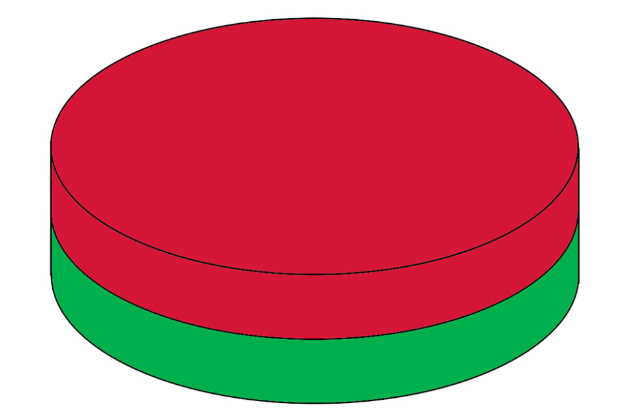What are disc magnets?
Understanding disc magnets: You might have come across the terms "disc magnets" or "disk magnets." Both refer to magnets that are round and flat, resembling a disc. If the magnet has axial magnetization, the magnetic poles are located on the large flat surfaces (as illustrated below with a horizontal separation). Conversely, if a disc magnet is diametrically magnetized, the poles are divided across the magnet's diameter in a vertical line. Most disc magnets feature axial magnetization, as enhancing the magnets' lateral strength is generally unnecessary and is more relevant for bar magnets.

What are neodymium disc magnets?
Neodymium disc magnets are permanent magnets, meaning they generate their own magnetic field without needing electricity. This natural attraction and repulsion mean they're not just incredibly useful but also boast an impressive lifespan: they can last up to 100 years without exposure to impacts or high temperatures.
What are ferrite disc magnets?
Ferrite disc magnets are fundamentally similar to their neodymium counterparts but are made from a different, less magnetically intense material. Hence, they are more affordable than neodymium magnets. Next time you're traveling, flip a souvenir magnet over; chances are, a ferrite disc magnet is attached to its back.
Uses for disc magnets
Disc magnets have a myriad of everyday applications, far beyond just sticking notes on a fridge or whiteboard. Many disc magnets are used commercially, where their purpose is to be functional, not necessarily visible, aiding in daily tasks. Here are some examples of inconspicuous everyday magnets:
- In mobile phone covers
- As purse clasps
- Door locks
- For sign hanging
- In knife strips
- Wireless switch sockets
- Canister lock mechanisms
- On/off switches in hotel hairdryers
- Click closures for drawers
- Coffee press suspension
All these uses share the commonality of making daily life easier or solving a problem where drilling isn't an option. For instance, did you know there's a housing cooperative in Amager, Copenhagen, where residents live in containers and use magnets for hanging everything? Keep an eye out next time you're at work or shopping; you might notice things like magnetic assembly of office shelving, floating signs, fitting room click locks, or clothing security tags.
However, it's not guaranteed that a disc magnet was used for these applications - it could be a block magnet or a rod magnet. But recognizing the magnets around you can be quite fascinating and opens up a new perspective on everyday conveniences.
Magnets as daily aids
Magnets also simplify daily tasks. For example, did you know magnets can be used to:
- Extract stuck batteries from devices like remote controls, since batteries are magnetic and can be pulled out with a magnet.
- Locate screws and nails (except aluminium) - not just those dropped on the floor but also those embedded in walls.
- Replace clips - magnets effectively seal everything from coffee bags to dog food packages.
- Hang tools within easy reach, avoiding clutter in the toolbox.
- Serve as handles to move sharp objects safely, like a deli slicer blade or a saw blade.
How strong are disc magnets - and which are the strongest?
On our product pages, you'll find N-values for neodymium magnets and Y-values for ferrite magnets. The higher the number, the greater the magnet's holding force (i.e., strength). So, if you're choosing between an N35 and an N52 magnet, opt for the N52. As a rule of thumb, anything above N45 denotes high strength and quality, preferred by enthusiasts. However, thinner magnets, like those 1 mm thick, might be better off with a lower N-value to prevent fragility. An N35 disc magnet at 1 mm thickness could be more suitable than an N45, depending on your project.
Different shapes of magnets
Disc magnets are only one of the possible shapes - you get both ferrite and neodymium magnets in many different shapes. To name just a few, you can find them as blocks and cubes, rings, rods and cylinders. You will find them all here at Magnetpartner. And we are happy to help you finding the correct shape of magnet for your project. Just contact our customer service all week days in our work hours and we will give you some links for possible magnets for your project in the shape that is best or strongest for your needs. We’re always here to recommend the best magnet for your specific task.